

- #Mac pro 1 1 2006 monitor compatibility install#
- #Mac pro 1 1 2006 monitor compatibility drivers#
- #Mac pro 1 1 2006 monitor compatibility driver#
- #Mac pro 1 1 2006 monitor compatibility windows 10#
- #Mac pro 1 1 2006 monitor compatibility Pc#
Most often these days that will mean a SATA connector, but you can buy SSDs with the older IDE/PATA/ATA connector from, say, OWC MacBook Airs use different connectors again. Other World Computing even makes one specially for the 2009–2012 Mac Pro.Ĭheck you get one with the correct connector, too. 3.5-inch SSDs are rare, though they do exist, but you can convert 2.5-inch drives to 3.5-inch ones with a bracket one might even be included with your 2.5-inch SSD, but if not, buy one separately. For laptops and the Mac mini, this typically means a 2.5-inch drive-though the MacBook Air has always used more exotic and different options throughout its life-while for desktops 3.5-inch drives are more usual this isn’t a hard-and-fast rule, though, so do check your specs carefully. Yes, it’s usually a colossal pain, but it’s often the most effective way to reinvigorate your Mac if you can set aside the time and accept the temporary disruption.īe sure you get the right form factor. Instead, manually copy all your documents across and reinstall your apps from the App Store or CD-omitting those you don’t need.
#Mac pro 1 1 2006 monitor compatibility install#
Usually, a Mac that has slowed further and further down has just accreted apps, files and more, and one of the surest ways of restoring the pep and vigor it had out of the box is to wipe the hard disk, install a fresh OS, and then, crucially, don’t clone everything across using Time Machine or the like. Oh, and never be tempted to install MacKeeper. One good idea is to run Verify Disk in Disk Utilities (/Applications/Utilities) on your main startup disk every now and then to identify problems, and watch the SMART status for your boot drive in Disk Utility too it’s monitoring for signs of imminent failure. These days there’s less need for that, but there’s usually no harm. In the early days of OS X, we regularly repaired permissions and ran apps such as Cocktail or OnyX to clear caches and more to keep the system trim and tidy. (And don’t ever bother with “RAM cleaning” or flushing apps OS X takes care of that for you.) Again, you can sort the RAM chart by Memory to see what apps are demanding RAM consider quitting RAM-hogs if you’re not actively using them. Start using your Mac as you would typically, and if the Memory Pressure graph on recent OSs isn’t looking full, you don’t need more RAM on earlier systems, if the pie chart of RAM use shows mostly green and blue, the amount of RAM you have is “cool” if it’s mostly red and yellow, you’re in hot water, and need to add more. If you’re trying to run many, complex apps at once, your Mac might struggle. If you don’t recognize a process, Google it it might be a background app that’s run rogue.Īctivity Monitor will also show you pressure on your memory (RAM). This will show you what applications are demanding the most from your main processor (CPU) click the %CPU column header to sort by this, and ensure you’ve selected All Processes from the View menu. So your first diagnostic step is to launch Activity Monitor (/Applications/Utilities) and see where the pinch points are.
#Mac pro 1 1 2006 monitor compatibility drivers#
Downloading the Realtek drivers direct from this site fixed this though.Like a doctor, you need to understand why your Mac is sluggish before blundering in with treatments.

#Mac pro 1 1 2006 monitor compatibility windows 10#
Windows 10 had installed some default drivers but the volume control didn’t have any control over the speakers plugged into either the front or rear audio out. Without getting all the Windows drivers installed in one go from Bootcamp, the only other thing I missed initially (before finding this post), was Audio drivers.
#Mac pro 1 1 2006 monitor compatibility Pc#
As long as you can get to the boot screen and pick which partition to boot from then this is ok (although since I’ve also added a PC version (unflashed) of an Nvidia 750 Ti, whenever I want to switch OSes, I have to switch my monitor cable between the stock Mac ATI card, and then switch it back to my 750 Ti after I’ve picked which OS I want to boot). to select to boot back to MacOS from Windows. The main feature I’m particularly missing is the Bootcamp systray app in Windows to allow you to pick your boot drive, i.e.
#Mac pro 1 1 2006 monitor compatibility driver#
The Bootcamp driver download from Apple though is no longer supported on a 2008: Windows 10 runs surprisingly well on my (new) Mac Pro 2008.


 0 kommentar(er)
0 kommentar(er)
